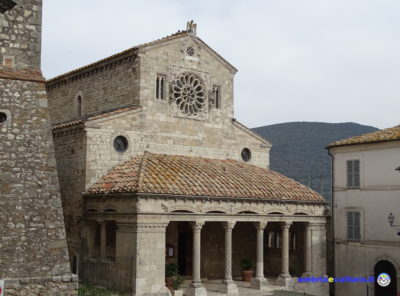Lugnano in Teverina, whose origins are still uncertain, is a characteristic small village near Amelia.
Entering through the door of the turreted wall and strolling along its narrow streets, on which unexpected glimpses open, unexpected treasures of art and history are waiting to be discovered.
Between elegant palaces, squares and convents, as you go further you take a journey back in time: shops with small signs, houses, clothes hanging to dry in the sun, the scent of the delicacies that the housewives are preparing for their loved ones. Everything brings us back to a lost human dimension.
The vast panorama over the Tiber valley from Lugnano in Teverina gives way to the narrow streets of the historic center, which suddenly open onto the main square, dominated by the most precious of Lugnano’s jewels: the Church of Santa Maria.
Probably built in the XII century, this place of worship was the center of the religious, social and political life of the inhabitants of Lugnano in Teverina: under his remarkable pronaos, the population gathered in assembly, as evidenced by a plaque from 1230 still clearly visible, walled to the left of the entrance door.
Already outside the church fascinates with its beauty and the wealth of symbols and religious messages: I am intrigued by one of the capitals of the columns of the pronaos, where 4 human faces are depicted from whose ears come out stems that intertwine with each other, with a flower at their peak: they indicate listening and obedience to the word of God.
The rose window, the symbol of Heaven (round) inscribed in a square (the Earth), presents, in the number of openings, the number eight or multiples of it: the number eight alludes to the Resurrection through baptism. The eagle that grabs a lamb is the symbol of the ferryman of souls who brings the righteous to Heaven.
Another detail is to be noted: at the apex of the facade there is not a cross, as in most buildings of Catholic worship, but an eagle with spread wings: this time the symbolism comes from a passage from the Apocalypse, which tells of the struggle of the Woman against the red dragon: “the wings of the great eagle were given to the Woman”, the eagle therefore represents the militant Church, the Virgin who fights against evil.
Inside, the first thing that is striking is, of course, the beautiful mosaic floor, whose colors, in turn, allude to the three theological virtues: white Faith, green Hope, red Charity.
Here too, the capitals of the columns of the three naves are noteworthy: dating back to different periods, and of different value, some have rudimentary acanthus leaves, another a woven motif, but another one, the more complex, it represents the consecration of the Eucharist.
Through the windows it is possible to admire the crypt, under the altar, which has two rows of columns with capitals decorated with acanthus leaves.
A double staircase allows access to the level of the altar with the stone ciborium, where it is possible to admire a triptych of the pupil depicting the Virgin assumed into heaven, and under it the heraldic coat of arms of the Land of Lugnano. At this level there is the pipe organ of 1756 built by the Tyrolean Giovanni Corrado Verlè, originally built in the church of S. Chiara.
The Antiquarium of Lugnano in Teverina, preserves the finds found in the excavation campaign conducted in the nineties in the archaeological site of the Roman Villa of Poggio Gramignano, famous for having revealed, inside some of its rooms, a children’s cemetery dating back to the fifth century AD, and the Civic Museum of the First World War 1915-18, which, from a first nucleus of relics belonging to dr. Luigi Canepone, has developed and enriched himself with further donations.
Benedetta Tintillini
Find Lugnano in Teverina on Google Maps:



